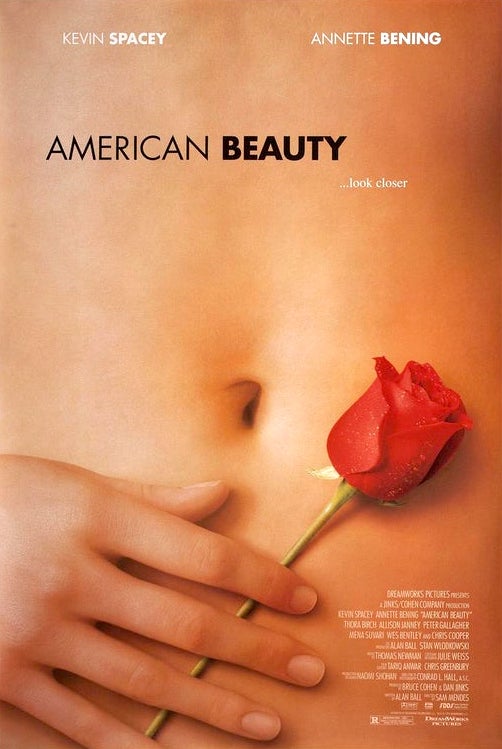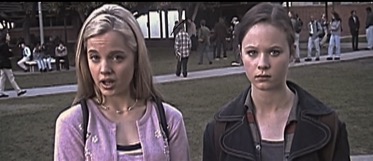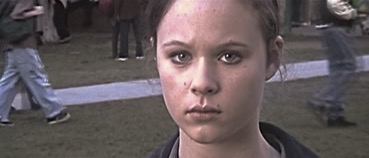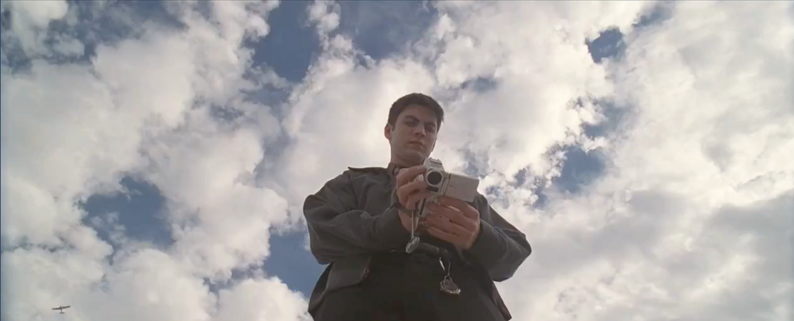Despite its iconic lusty red petals, Sam Mendes’ American Beauty is abundant with other striking images – one of which is a dead bird, lying on the grass of the school grounds, under the lens of Ricky Fitts’ camera. The bird becomes part of a vision of freedom and liberation, in a film where most of the characters feel constrained by obligations to societal expectations and their mundane, everyday lives (represented by protagonist Lester Burnham.)
The bird is only shown once on screen, for mere moments, but it is surrounded by three different people all with differing ways of looking at the world. Mendes chooses to show the reactions to the dead bird of all three teenagers, meaning that is becomes a blank canvas (reinforced by its white colour, tarnished only by its severed neck) for them to map their own views of the world on to. A swift upward pan from the dead bird to Angela and Jane reveals the girls’ reactions. Angela’s face contorted with disgust clearly displays her feelings towards the bird and Ricky’s alternate vision of the world. She aligns the idea of the dead bird being beautiful with mental illness and lunacy. The white bird offers a stark contrast to Angela, an embodiment of a conventional sexual beauty, emphasised by the lustful red petals in Lester’s fantasies. Her reaction to the bird confirms her narcissism.
The two shot zooms into a medium close-up of Jane’s face, on which there is significant lack of the disgust shown by Angela. This indicates a sympathy with Ricky, an underlying willingness to see what he sees. Their relationship then prospers from this point, therefore the dead bird becomes a vehicle for the development of their relationship, binding the two teenagers in this shared perception of the world.
The choice of the bird as this vehicle is central to the film’s overarching message of escaping the mundanities of everyday human life, because the soaring bird is the ultimate image of freedom and liberation. A bird, when flying through the sky, has freedom of movement and can temporarily resist gravity. The dead bird here proves that this is reversible. When the bird dies, it can no longer fly, and it is now completely grounded. The same can be applied to the human life – living life day in, day out, doing as is expected and viewing the world conventionally, one can soon feel ‘dead’, just as Lester does at the start of the film. This is the human equivalent to being ‘grounded’, pulled down, unable to be free as the bird is when it dies. Yet, if a human decides to live, to ‘spread their wings’ like the bird does – as Lester does, when he quits his job and tries to induce a love affair with Angela – the world can be reanimated and looked at it in a different way, and the person can be free from the bores and restraints of their everyday life.
A bird can make a choice between flying through the air or living on the ground, and Mendes shows that the human can too through the character of Ricky and his relation to the bird and later, a plastic bag. Before we see the bird, we see Ricky holding his camera, as he towers over the bird. This places him in a God-like position, as a creator and an omniscient viewer of the world. The low-angle shot places him among the clouds whilst the bird is in the ground, framed in Ricky’s grainy, handheld camera, high-angle shot. Here, the human and the animal have swapped places as Ricky is surrounded by sky. He is looking to reanimate the world, through a new vision, making the choice to figuratively fly free like the bird. His alternate vision of the world, in which a dead homeless person is perceived as beautiful, is bore by his choice to break free from the mundanities of human everyday life.
The idea of this choice between personal freedom and the constraints of society and the everyday is furthered through Ricky’s filming of the plastic bag, which has striking visual similarities to the bird, aligning the two together. The bird and the plastic bag together serve to prove that the world can be reanimated and that the status quo does not necessarily have to be maintained, that the world and the way people lead their lives can be changed. The plastic bag is normally a commodity, used and then thrown away. Certainly, when Ricky films it, it is litter but here Ricky makes the choice that it is flying and dancing, reanimated and rethought in his way of looking at the world. The bag’s colour (white, like that of the bird) and flight through the air means it becomes free like the bird. The bird and the bag therefore represent a choice that humans can make – to be ‘dead’ like the bird, grounded by the constraints of their mundane lives, or to ‘live’ like the plastic bag, dancing and flying despite its status as commodity and litter.
Indeed characters in the film make this choice – Lester escapes his job where he is treated like a commodity, and Ricky and Jane decide to run away. These characters choose to “fly” and live like a free bird.




